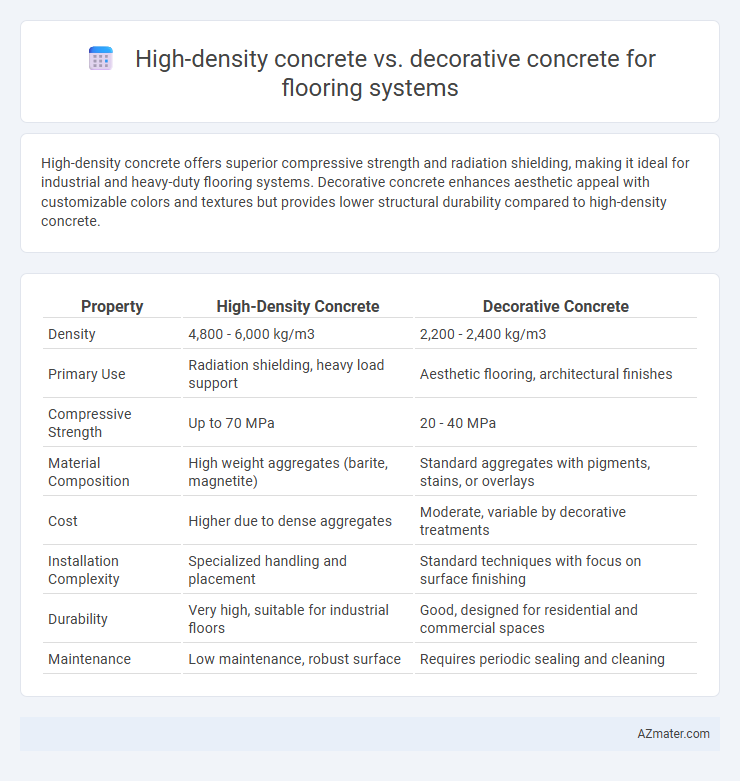High-density concrete offers superior compressive strength and radiation shielding, making it ideal for industrial and heavy-duty flooring systems. Decorative concrete enhances aesthetic appeal with customizable colors and textures but provides lower structural durability compared to high-density concrete.
Table of Comparison
| Property | High-Density Concrete | Decorative Concrete |
|---|---|---|
| Density | 4,800 - 6,000 kg/m3 | 2,200 - 2,400 kg/m3 |
| Primary Use | Radiation shielding, heavy load support | Aesthetic flooring, architectural finishes |
| Compressive Strength | Up to 70 MPa | 20 - 40 MPa |
| Material Composition | High weight aggregates (barite, magnetite) | Standard aggregates with pigments, stains, or overlays |
| Cost | Higher due to dense aggregates | Moderate, variable by decorative treatments |
| Installation Complexity | Specialized handling and placement | Standard techniques with focus on surface finishing |
| Durability | Very high, suitable for industrial floors | Good, designed for residential and commercial spaces |
| Maintenance | Low maintenance, robust surface | Requires periodic sealing and cleaning |
Introduction to Concrete Flooring Systems
High-density concrete offers superior strength and durability due to its high mass and dense aggregate composition, making it ideal for industrial and heavy-load flooring systems. Decorative concrete enhances aesthetic appeal through techniques like stamping, staining, and polishing while maintaining structural integrity for residential and commercial spaces. Both flooring systems serve distinct purposes where high-density concrete prioritizes performance and load capacity, whereas decorative concrete emphasizes visual design and customization.
Overview: High-Density Concrete vs Decorative Concrete
High-density concrete exhibits superior strength and radiation shielding capabilities, making it ideal for industrial and medical flooring applications where durability and protection are critical. Decorative concrete emphasizes aesthetic versatility with customizable textures, colors, and finishes, enhancing the visual appeal of residential and commercial floors. Both types serve distinct functional and design purposes, with high-density concrete prioritizing performance and decorative concrete focusing on style.
Material Composition and Properties
High-density concrete for flooring systems incorporates heavyweight aggregates such as magnetite or barite, resulting in increased density, enhanced radiation shielding, and superior structural strength. Decorative concrete typically uses standard aggregates combined with pigments, stains, or surface treatments to achieve aesthetic appeal while maintaining moderate strength and durability. Material composition in high-density concrete prioritizes mass and performance, whereas decorative concrete balances material properties with visual customization.
Strength and Durability Comparison
High-density concrete offers superior compressive strength and enhanced durability due to its dense aggregate composition, making it ideal for heavy-load flooring systems in industrial settings. Decorative concrete, while visually appealing with various finishes and textures, generally provides lower structural strength but maintains adequate durability for residential and commercial floors with moderate traffic. Choosing between the two depends on balancing the need for strength and durability against aesthetic requirements in flooring applications.
Aesthetic Versatility and Design Options
High-density concrete offers limited aesthetic versatility, primarily designed for structural strength and durability rather than visual appeal. Decorative concrete provides extensive design options, including custom colors, textures, patterns, and finishes that enhance the visual impact of flooring systems. These design capabilities make decorative concrete ideal for spaces requiring both functionality and unique, attractive flooring solutions.
Installation and Application Techniques
High-density concrete flooring requires precise mixing and placement techniques to manage its increased weight and density, often involving specialized equipment for handling heavy materials and ensuring proper compaction. Decorative concrete focuses on surface treatments such as stamping, staining, and polishing, which demand skilled craftsmanship and detailed finishing processes to achieve aesthetic appeal. Installation of high-density concrete emphasizes structural integrity and load-bearing capacity, while decorative concrete prioritizes design flexibility and surface customization during application.
Cost Considerations and Budgeting
High-density concrete typically incurs higher costs due to its specialized raw materials like barite or magnetite, making it suitable for industrial flooring requiring radiation shielding or heavy load-bearing capacity. Decorative concrete offers a more budget-friendly option with customizable aesthetics using stains, stamps, or dyes, balancing visual appeal with moderate durability for residential or commercial floors. Budgeting requires evaluating the concrete type's intended use, with high-density flooring demanding higher upfront investment and maintenance compared to cost-effective decorative solutions optimized for design flexibility.
Maintenance and Longevity
High-density concrete floors offer superior durability and low maintenance due to their dense composition and resistance to chemical exposure, making them ideal for industrial applications where longevity is critical. Decorative concrete floors prioritize aesthetics with customized finishes but generally require regular sealing and maintenance to prevent wear and maintain appearance over time. While high-density concrete excels in structural longevity, decorative concrete's lifespan depends heavily on upkeep and protective treatments.
Ideal Use Cases and Environments
High-density concrete excels in environments requiring enhanced radiation shielding, structural durability, and load-bearing capacity, making it ideal for hospitals, nuclear facilities, and industrial floors. Decorative concrete offers versatility for residential and commercial spaces by providing aesthetic customization through stains, stamps, and overlays, suitable for showrooms, patios, and office lobbies. Selection depends on balancing functional requirements like strength and protection against design preferences and surface appeal.
Conclusion: Choosing the Right Concrete Flooring Solution
High-density concrete offers superior durability, resistance to heavy loads, and enhanced shielding against radiation, making it ideal for industrial and specialized applications. Decorative concrete provides aesthetic versatility, customizable finishes, and cost-effective options suitable for residential and commercial spaces prioritizing design and ambiance. Selecting the right flooring solution depends on balancing structural demands with visual appeal, ensuring the concrete type aligns with the specific functional and aesthetic requirements of the project.

Infographic: High-density concrete vs Decorative concrete for Flooring system
 azmater.com
azmater.com